Smart Garment For Firefighters
|

Figure 1.
Two firemen under strenuous conditions
|
Smart Garment For Firefighters
Severine Gahide
Graduate program
North Carolina State University
Final Project TE 589
Spring 1999 |
Under the Direction of:
Dr. Michael S. Slocum
Adjunct Assistant Professor
North Carolina State University
Slocum1946@aol.com
Dr. Timothy G. Clapp
Professor
North Carolina State University |
Introduction
In the old time, firefighters used their big moustaches to
filter smoke and their ungloved hands or ears to sense temperature. Today’s
firefighters are equipped with special protective apparel which on one hand
protect them longer when exposed to a raging fire, but on the other hand,
prevent them from sensing the dangerous intense heat of a fire. The high tech
fabrics (like Nomex or Goretex) retain radiant heat until the gear is saturated.
At this point of no return firefighters start burning from the inside and have a
few seconds to quit their protective equipment. Temperature sensors now can
provide this lack of sensing information.
However, the current detection systems available on the
market have several flaws: weight, sensibility or accuracy and size. A sensor
plus a nine-volt battery and an alarm system are heavy. One unit does not
accurately reflect the temperature accumulation throughout the vest. Finally,
several detection units reduce the mobility of the firemen because of their
size. The purpose of this project is to identify if there are potential
improvements to these detection systems by using the Theory of Innovative
Problem Solving, also known as TRIZ. Several TRIZ tools will be used to
analyze this issue and to generate solutions: IFR, contradiction matrix,
separation principles, use of resources, ARIZ, 9 sub/super/system table,
maturity mapping. The solutions that are described could be the basis for a
doctoral research.
Background information
Protective equipment has to have two features: fire
resistant and water-resistant. The first property sounds trivial when
the second may be more surprising. Water droplets can absorb a tremendous amount
of thermal energy. Heated water is volatile and can release explosive energy in
the form of dangerous steam. Water from sweat, hose streams or rains is trapped
in the gear and frequently causes burn injuries without warning. There are no
sensors available on fireman’s jacket to detect inside moisture or super
heated steam formation.
Another asset that could be added to a firefighter’s jacket
is a locator system. Firefighters risk their lives when they get injured
and knocked down because of toxic fumes. The poor visibility associated with
stress and strain prevent their peers to find them if unconscious. Somehow,
there is an untold feeling of the fear to get hurt and not to be found. So far,
motionless sensors exist but are not widely used. The technology is based on
accelerometer sensors that send a signal to an alarm system when the person hasn’t
move for a pre-determined amount of time.
In conclusion, an efficient protective equipment should
include sensors that measure temperature, moisture level and send signals when a
motion or consciousness problem occurs.
Problem definition
Such devices like temperature sensors and motion detection
are already available on the market. Their main drawbacks are weight,
affordability, size, reliability and lifetime. In addition, there are no
moisture sensors inserted in the clothing layers to detect super heated steam.
- Is there a way to capture all information (temperature, moisture, and
location) at the same time?
- What improvement could be made to the existing jacket without having to
buy a new one?
The protective equipment should provide an accurate
information, and should be reliable, lightweight, not expensive, not
preventing the mobility of the fireman, washable and be optional when not
necessary.
- Level of Innovation
This is a level 2 or 3 problem. The number of trials and
errors is probably less then 100, but there is a need for an essential
improvement of the existing system and the solution may be outside the box, in
another field of engineering. Most likely the solutions will influence the
science and be use in other areas such as patients with special needs or
astronaut’s uniforms.
| Ideal Final Result
The actual jackets carry several detection systems:
two to three on each side. Each comprises a sensor, a power supply and
an alarm system. The Ideal Final Result would be that the jacket itself
is the detection system without an increase of weight or volume. If the
technology existed, the color of the jacket should change with an
increase of temperature |

Figure 2. PASS
system
|
Contradiction matrix
The main contradiction is:
- I want to detect an increase of temperature accurately. Therefore, more
detection systems have to be installed on the jacket.
According to the Altshuller’s 39 parameters:
- The improving feature is an accurate information (#28)
- The degrading features are the weight of detection systems increases
(several units on one jacket) (#2) and the volume of these detection
systems that reduces the mobility (#7).
Contradiction matrix suggested solutions:
- 28/2 = {28-35-25-26}
- 28/7 = {32-13-6}
Analysis of the solutions:
# 28 a): Replacement of a mechanical system by an optical,
acoustical or odor system.
- Balloons with a metered pressure could explode under an increase of heat
(thermal expansion principle). They could be programmed to explode
exponentially in frequency, in reference to the temperature. At the
beginning, there should be only a few "pops", like one every 10oC
increase. But after a given temperature, the balloons should pop up every 5oC
indicating that a certain level is reached, and so on, up to a continuous
popping sound. The secondary problem that arises is how to attach the
balloons to the inside of the jacket? Would the sounds be loud enough to be
heard? May be the special balloons tee shirt could be put on, under the
jacket.
- Another solution is an optical display of the temperature inside the visor
of the helmet. Instead of having an alarm that may increase the stress level
of the fireman, the actual inside radiant temperature of his jacket could be
displayed in his visor (science fiction movie like terminator, where the
hero has all kind of information in front of his eyes). But these special
helmet, also used by army pilots, are VERY expensive…. But in the future,
the technology may become more affordable and this solution may be viable.
- I can’t imagine any odor system to be efficient because of the polluted
environment. Although, it would be quite easy to have bulbs filled with gas
that would also explode under an increase of pressure caused by the thermal
expansion of gas. These bulbs would liberate some specific smells. But, it
won’t work because of the fumes.
# 28 b): Use an electrical, magnetic or electromagnetic
field for interaction with the object.
- The power supply is the heavy part of the detection systems, so may be the
jacket could have only one battery/alarm and several sensors in the jacket
that would be wireless. The sensor could send the information to the central
power unit. (See ARIZ for further details).
# 6 Universality of an object that performs multiple
functions thereby eliminating the need for some other objects.
- If all types of sensors are connected to the same power and alarm system
then there is no need for three different detection systems. One system can
combine any information given by one of the sensor and process the output.
See US patent 4407295 in Appendix 2.
#35 Transformation of physical and chemical states of
an object, #25 Self-service didn’t inspire me. #26 Copying, #32
Change of color and #13 Inversion are not relevant to the problem.
- Separation principles:
The problem could almost be stated as a physical
contradiction:
I want an accurate information, but I don’t want to carry it. I want a
weight of a nonmoving object but I don’t want it at the same time.
means that sometime carrying the extra weight
may be acceptable because of the great benefit of the information provided but
other time the information may not be that important or critical while
mobility, agility and speed (meaning light weight) may be the crucial factors.
Unfortunately, firemen have one jacket for all duties. The innovative solution
should take into consideration the flexibility to have or not to have the
detection system if they want or not, depending upon external conditions.
The separation of space means that the detection system could be divided
into several parts. Some of the heavy parts (alarm and battery) could be
displayed in such a way that they could be removed where as the sensors (light)
could be permanently sewn inside the jacket.
Use of resources
There is an obvious resource that is not used which is free
and plentiful: HEAT. The UFOZ showed that the battery was the heavy part and was
necessary to perform the useful function. May be heat could provide the power
supply for the alarm system. So as the heat increases inside the jacket, storing
radiant heat, some of this energy could be transformed into some useful electric
energy that rings the bell. In that case, the higher the temperature, the more
energy is transformed and the more audible the sound warning system is. The
harmful effect is transformed into a useful function.
The problem is to find the phenomenon or physical principle
effect that could do it. TechOptimzer, from Invention Machine should help to
find this phenomenon.
ARIZ
9.1 Mini problem formulating:
9.1.1 The problem is the increase of weight (lack of
mobility) caused by the addition of temperature detection systems (TDS) on a
fireman’s jacket. Thus the Direct Key Knot is the following:
|
Attaching more TDS to the jacket
|
(+) More accurate detection (360 degrees)
(-) Heavier jacket and less mobility |
9.1.2 Determine the Useful Function, its Product
and Tool.
Action: to detect at 360o
Product: TDS
Tool: the sensors
9.1.3 Determine the Harmful Function, its Product
and Tool.
Action: to increase weight
Product: TDS
Tool: the batteries and alarm systems
9.1.4 Common element in the
useful and harmful functions:
Increasing the number of TDS.
9.1.5 Render the Graphical Scheme of the
conflict:
|
Number of TDS |
More accurate detection
Weight increases and mobility decreases |
9.1.6 Additional condition is: A lot of TDS
|
Adding a lot of TDS |
(+) Excellent detection accuracy (360o)
(-) Very heavy |
9.1.7 Formulate the Functional Initial Contradiction
IC-1 corresponding to the direct conflict:
IC-1:
If there are a lot of TDS then (+) the accuracy
of detection is improved to 360o but (-) the weight increases too.
9.1.8 Render the scheme of the Reverse Key Knot:
|
One TDS |
(+) The jacket is light, the mobility increased
(-) The detection is poor (and not safe) |
9.1.9 Render the Graphical Scheme of the Reverse
Conflict:
|
One TDS  |
Accurate detection
Increase of weight |
9.1.10 Formulate the Functional Initial Contradiction IC-2
corresponding to the Reverse Conflict:
IC-2:
If there is one TDS then (+) the weight stays low
but (-) the detection is not accurate.
9.1.11 Formulate the Mini-Problem:
There is a minimum number of TDS necessary for an accurate
detection (UF) of temperature but weight and mobility become a problem.
IC-1: If there are a lot of TDS then (+) the
accuracy of detection is improved to 360o but (-) the weight
increases too.
IC-2: If there is one TDS then (+) the weight stays low
but (-) the detection is not accurate (not 360o).
It is essential to find a system to accurately detect an
increase of temperature without exceeding the weight or reducing the mobility
of the fireman.
9.2 The pseudo-Fundamental Contradiction Formulating and
Resolving
9.2.1 Formulate the Pseudo-Fundamental Contradiction (PFC):
Number of TDS (useful Function Tool) should be big (in
state A1) for detecting accurately at 360 degrees (performing the UF) and
should be low (in state A2) to keep the weight down (Harmful Function).
9.2.2 Try to resolve the PFC using the principles of Fundamental
Contradictions Resolving:
It is possible to resolve this contradiction by using
separation principle of time and space.
All details are available in the section 6
"Contradiction matrix".
9.3 Conflict Enforcement
9.3.1 Enforce the conflict described in IC-1:
If there are too many TDS then (+) the detection is
perfect and covers 360o but (-) the weight increases way too
much, and eventually the fireman has no mobility and can’t perform is job.
9.3.2 Enforce the conflict described in IC-2:
If there is no TDS then (+) the detection is null but (-)
there is no weight (IFR).
Possible solutions: the temperature detection has no
weight because it is a part of another object the firefighter has to have.
Another solution might be a change of color of some object, indicating that
the temperature changed to a critical point. Color is weightless. May be a
tainted glass changing with temperature, in the visor of the helmet? The
technology may not exist yet, but it could be an area of research for
directed evolution of this product. Finally, the use of color patches, based
on liquid crystal principle could be another solution. Some patches could be
inserted in some parts of the jackets and give relevant information about
the temperature of the vest. The secondary problem is how do you read the
color changes on the back of the vest? May be this solution could be the one
for the arms and front of the jacket, when a acoustic sounds would be used
for the back.
9.4 Formulating Directions for Solutions
The useful function detecting accurately has to be
performed but that the weight has to be kept to a minimum.
9.4.1 Formulate the Model of Problem for the conflict IC-1:
IC-1:
If there are a lot of TDS then (+) the accuracy
of detection is improved to 360o but (-) the weight increases
too.
So the number of TDS increases but it is essential to
introduce an X-resource, which prevents an increase of weight (Harmful
Function), while performing the Useful Function: accurate detection. In other
words, an increase of TDS should provide an increase of sensors (useful tool)
to enhance the detection (useful function), but the harmful tool should be
reduced to the minimum: one or no batteries/alarms systems. Wireless
sensors may be the solution. The sensors are placed on the jacket
virtually weightless and emit a signal. A central unit made of a battery and
an alarm system will warn the fireman of an increase of temperature.
9.4.2 Formulate the model of Problem for the conflict IC-2:
IC-2:
If there are a few of TDS then (+) the weight
stays low but (-) the detection is not accurate (not 360o).
The second approach to the problem is to introduce the
X-Resource that provides 100% of the detection with one battery/alarm
(eliminate the Harmful Function). The resource could be wires that
interconnect all sensors together. Therefore, one battery and one alarm system
form a central unit and the sensors can be wired to it.
9.5 Using Substance-Field Transformations
9.5.1 Render the initial SU-Field model for the Problem on
step 4.1:
IC-1: If there are a lot of TDS then (+) the accuracy
of detection is improved to 360o but (-) the weight increases too.
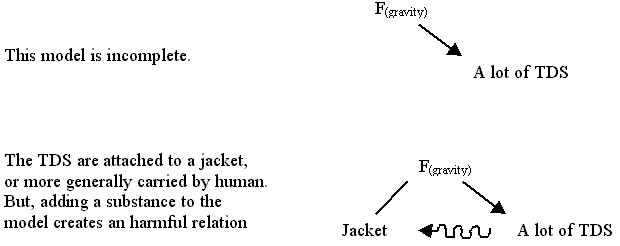
9.5.2 Solve the problem with SU-Field Transformations:
Principle of fantastic idea generation # 4: Separation: TDS
is decomposed in two substances: one harmful (battery) and one useful
(sensors).



9.5.3 Render the initial SU-Field Model of the problem on
step 8.4.2
IC-2:
If there are a few of TDS then (+) the weight
stays low but (-) the detection is not accurate.

The model is incomplete. Let’s decompose again the TDS
into subsystems.
9.5.4 Solve the problem with SU-Field Transformations:
For one TDS

The SU-Field model above represents the problem more
accurately but there are two insufficient effects, each of them modeling the
accuracy of the detection (performing the useful function).
Standard 76 solutions solve this problem by multiplying the
S1 to create sufficient effect. A new substance S3 needs to be introduced into
the model to connect the S1 (sensor unit) together.
Let’s multiply S1:
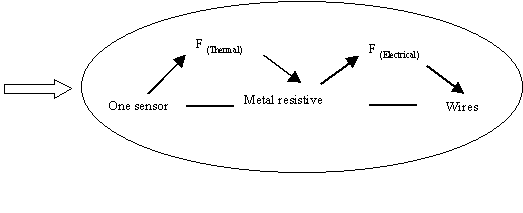
The final Su-Field Model:

9.6 Operational Zone Analysis and Resources Discovering
9.6.1 Determine the Operational Zone (OZ)
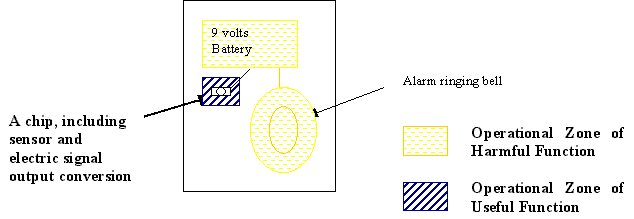
Figure3. Detection unit - The operational zone analysis
clearly indicates that there is no zone of conflict between the useful and the
harmful operational zones. Therefore, they can physically be separated.
9.6.2 Determine the Operational and Resource Time
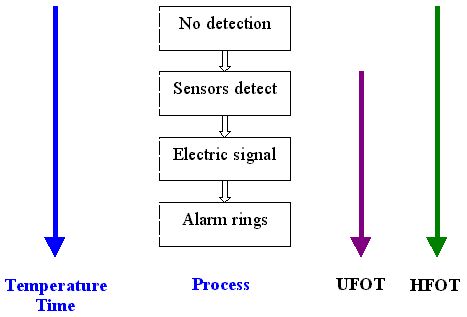
Conclusion
There is no need to continue the ARIZ because I have
already found the solution to the IC- 1 and IC-2. The initial contradictions
were solved at the section 8.4.1 and 8.4.2. The Su-Field analysis helped to
formulate the solutions. The operational zone and operational time didn’t
bring anything new to the problem that wasn’t identified before. This
problem is not a level 4 problem but more likely a level 2 or 3. Other TRIZ
tools are more relevant and may generate more innovative solutions.
- Nine windows to the problem
| |
Past |
Present |
Future |
|
Super system |
The brain/body |
Whole garment wired
and connected to chip |
Develop new generation
of fibers (research, funds) |
|
System |
Human detection |
Sensors detection |
Garment detects itself |
|
Sub system |
Eyes-nose |
Sensor, battery, alarm |
Smart fibers / smart coating |
- Maturity mapping and patent research
Several patents were available in the literature. The IBM
search engine references patents from 1970’s and after. The first patent is
an hyperlink connected to the IBM search engine. The research was organized
upon four axes: 1) sensors (temperature, motion and moisture) used in
garments, 2) temperature and sensors used in the medical field, 3) garments
made of special fabrics or special structures that should be used, and 4)
cooling system in garments. Level 3 problems look at other fields to solve
problems and monitoring patients temperature is very close to monitoring
temperature of a fireman vest. All patents are in Appendix 2, with some
highlights. Some of the solutions presented are greatly inspired from these
patents. Therefore, they will be referenced.
11.1 Sensors technology to detect temperature, moisture or
location
US4264892 1978
Alarm device (first basic temperature-alarm system)
US4520352 1983 Fire alarm system and method
US4575715 1984 High temperature alarm system with fusible link
US4814766 1987 Fire alarm and heat detection system and apparatus
US4988884 1988 High temperature resistant flame detector
US4914422 1989 Temperature and motion sensor (PASS products)
US5200736 1991 Assembly for monitoring helmet thermal conditions
US5157378 1991 Integrated firefighter safety monitoring and alarm system
US5541579 1995 Personal alarm safety system
11.2 Medical patents on temperature and moisture
detection systems
US3620889 1968* Liquid crystal systems
US3661142 1970* Temperature-sensing patch
US3633425 1970* Chromatic temperature indicator
US3765243 1972* Temperature indicator
US3830224 1972 Means for detecting changes in the temperature of the skin
US4407295 1980 Miniature physiological monitor with interchangeable sensors
US4437471 1982* Implement for measuring skin temperatures
US4763112 1987 Automatically self-alarming electronic clinical thermometer
US5174656 1991 Temperature measurement system
US5802611 1997 Releasable clothing with temperature sensor for bedridden
patients
The main technical innovation in this field was the liquid
crystal temperature indicator in the 70’s. It is widely used in medical but
nonexistent in the protective apparel field. Patents with a * are based on
this technology. The other patents are just ideas patented that really could
be "cross field" improvements and used for protective equipment for
firefighters.
Figure 4. is a performance vs. time plot of temperature
detection systems regardless of the field or technology used. This liquid
crystal principle has clearly reached its mature stage and the new generation
of sensors is the next step. Sensors haven’t reached yet the mature stage.
-
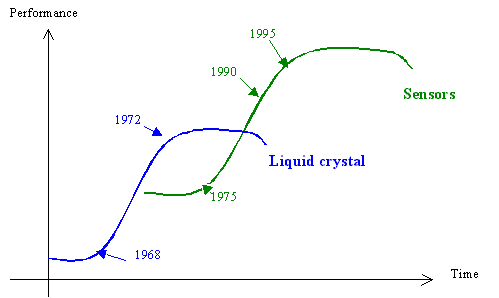
Figure 4. Performance vs. Time of Temperature Detection Systems
11.3 Special fabrics
US3710395 1973 Air distribution garment
US3849802 1974 Temperature protection suit
US4401707 1981 Composite heat protective fabric
US5001783 1991 Firefighter’s garments having minimum weight and excellent
protective qualities
US4748691 1998 Firefighter’s coat with stabilized waterproof collar
These patents are related to actual fabrics that could be used for firemen’s
jacket. They all have layers of fabrics with unique properties (waterproof,
thermally reflective) and allow the insertion of sensors, pressured
balloons, or cooling devices (see below) in between the layers.
11.4 Cooling principle
US3950789 1975 Dry ice cooling jacket
US4738119 1987 Integral cooling garment for protection against heat stress
US5146625 1991 Cooling vest
There are only a few patents on this topic. Although it’s
a great idea, it was not successful commercially. This cooling principle could
be used as a GREAT-MAJOR breakthrough improvement for firemen. At this point
of no return when the garment as stored so much radiant heat that it can’t
take it anymore, a trigger could be set to free some dry ice and therefore
give an extra time for the firemen to run away. Dry ice is very light and
quite inexpensive.
The trigger could be made of heat shrinkable material (US
4814766 and US4520352). They are thermoplastic film tapes that have a
substantial drop in tensile strength at a given temperature. The dry ice could
be stored in a bag closed by these heat shrinkable tapes. As the temperature
reaches a critical point, the tape breaks and releases the dry ice into the
layers of the jaclet. Storage would be a secondary problem that would need to
be addressed.
- Summary of solutions
Several innovative solutions and general improvements were
suggested along this report:
Jacket should:
- Be made of layers (US4401707)
- Be water resistant (US 4748691)
- Be Fire resistant
- Have air layers (US5001783) to insert balloons of pressured air, sensors
and wires or a cooling system (pipes and pockets of ice)
- Have a cooling system (S3950789, US4738119, US5146625)
The detectors should detects:
- Temperature: with sensors, metered pressurized balloons or liquid
crystal change of color
- Moisture (US 5802611)
- Locator system and/or a conscious detector (based on breathing?) that
should beep if a person is unconscious (US4407295 or US4914422) or
breathes differently (US5157378)
The alarm should:
- Ring with electric field or the use of thermal field
- Pop of balloons
- Be visual in the visor of the helmet
- Be patches changing colors with temperature (section 8.3.2. and
US3661142)
- Have a wrist watch display (US4407295)
- Trigger a cooling life-saving device
- The trigger could be made of heat-shrinkable tape
In addition:
- All sensors should be connected to one alarm and one battery (See
Appendix 1: smartcoat
technology)
- All sensors should be wireless and sending information to a central unit
located in the helmet (US5200736), in the buckle (US5541579) or the
shoulder harness (US4914422).
- The detection system chosen should not be restricted to the jacket but
widen to the pants and gloves.
- If there is any heavy parts, they should be optional, like a plug-in
system (section 8.6.2) or use Velcro tapes (US4763112).
Appendix 1:
Some products are available and commercialized.
- The Pass system gathers several sensors together: temperature and motion.
Its weight: 7 oz.
- The smart coat has six sensors connected to one central unit and provides
a more accurate detection.
The Pass System
-
 |
- The SUPER PASS® will sound a
loud audible signal if the wearer becomes immobilized or
motionless for a 25 second time period.
- SUPER PASS® also provides a manual CALL FOR HELP
feature that is easily activated, even with a gloved hand.
- If the wearer is exposed to excess temperatures, SUPER
PASS® will sound an easily recognized,
rapid ring
- SUPER PASS
® is small, light, and all
electronic switching for enhanced reliability.
|
Specifications
- Dimensions
: 2" wide x 3-1/4" high x 1-1/8"
deep
- Weight
: Seven ounces with battery
- Motion Detector
: Solid state accelerometer
- Case
: Rugged waterproof polycarbonate plastic
|
- Visual
: High intensity wig-wag LED indicators
- Sound
: Sweep type, 2 thru 3 kHz, 103 dBA @ 10 feet
- Battery
: 9 volt alkaline battery
- Battery Life
: 300 hrs. - sensing mode; 2 to 4 hrs. - alarm
|
The smart coat



- Six Silicone encapsulated heat sensors work independently of each other.
They are strategically placed on the chest, back, and arms of the coat.
- Electronic housing made of high temperature resistant plastic can be
easily removed for battery replacement and coat cleaning.
- Microprocessor evaluates heat sensor conditions every ten seconds until
one sensor or more reaches 100 F., then monitors every sensor every second.
- Alarm sounds when the microprocessor predicts that an interior coat
temperature of 150 Degrees F will be reached in one minute or less.
Distinctive alarm sound.
- Separate 9 volt battery compartment Test button tests battery, checks
continuity of system, and reboots microprocessor.
Appendix 2:
All patents referenced in section 11 and before are partially
displayed and have some comments and highlights that may have disappear if
copied. They all can be found on internet at: http://www.patents.ibm.com/
2.1 Sensors technology to detect temperature, moisture or
location
US4264892
1978 Alarm device (first basic temperature-alarm system)
US5157378 1991 Integrated firefighter safety monitoring and alarm system
US4914422 1989 Temperature and motion sensor (PASS products)
US5200736 1991 Assembly for monitoring helmet thermal conditions
US5541579 1995 Personal alarm safety system
US4520352 1983 Fire alarm system and method
US4575715 1984 High temperature alarm system with fusible link
US4814766 1987 Fire alarm and heat detection system and apparatus
US4988884 1988 High temperature resistant flame detector
2.2 Medical patents on temperature and moisture detection
systems
US3620889 1968* Liquid crystal systems
US3633425 1970* Chromatic temperature indicator
US3661142 1970* Temperature-sensing patch
US3765243 1972* Temperature indicator
US3830224 1972 Means for detecting changes in the temperature of the skin
US4437471 1982* Implement for measuring skin temperatures
US5174656 1991 Temperature measurement system
US5802611 1997 Releasable clothing with temperature sensor for bedridden
patients
US4407295 1980 Miniature physiological monitor with interchangeable sensors
US4763112 1987 Automatically self-alarming electronic clinical thermometer
2.3 Special fabrics
US3710395 1973 Air distribution garment
US3849802 1974 Temperature protection suit
US4401707 1981 Composite heat protective fabric
US5001783 1991 Firefighter’s garments having minimum weight and excellent
protective qualities
US4748691 1998 Firefighter’s coat with stabilized waterproof collar
2.4 Cooling principle
US3950789 1975 Dry ice cooling jacket
US4738119 1987 Integral cooling garment for protection against heat stress
US5146625 1991 Cooling vest
Conclusion on TRIZ:
I learned a new way of thinking. I was proven that I don’t
have to jump and accept my own quick solutions because TRIZ will bring me, in a
systematic way, to the solutions I could have found by myself AND in addition
will give me new ones.
I found ARIZ to be exhaustive and long for a simple technical
contradiction. The contradiction matrix is powerful enough to give a good set of
solutions.
In regards to this project, I have to admit that I had
pre-guessed some improvements but not all of them. For example, the
contradiction matrix suggested "solution 28 a: replace the system by an
acoustic, optical or odor system". That’s how the popping balloons came
to my mind. The patent research definitely gave me a lot of ideas for
improvements. I gained some knowledge in the crystal liquid principle widely
used in medical area but absolutely ignored in protective apparel. It’s cheap,
reliable, exists since the 70’s and is clearly at a mature stage. So why is it
ignored? Through the patent search, I also discovered that cooling vests already
exist for burnt patients since 1975. Why isn’t used for protective apparel?
TRIZ taught me to look outside the box and convinced me that
my solution is already somewhere else, in another area. In the future, I’ll
use TRIZ in my professional technical problems.
I’m thankful that I was a part of this class and I wish you
good luck for your center and development of this theory in the United States.








